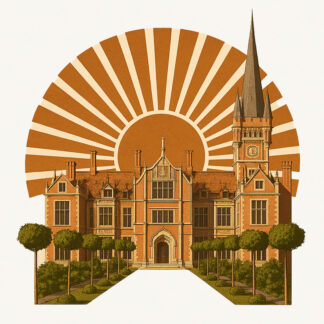Flower Essences – Nature’s Hidden Treasure
Have you ever wondered if flowers, crystals, or even plain water could possess healing power that science has yet to fully understand? Vibrational essences are subtle energetic preparations made from natural elements, such as plants or gemstones, and used to restore harmony in the human body, mind, and spirit. They work through energetic codes called biopatterns, which are believed to transmit information capable of promoting emotional peace, spiritual awareness, or even physical well-being. In this article, we will explore the origins of vibrational essences, their creation methods—including modern radionics techniques—and how they can help in the modern world. We will also look into the history and scientific context of biopatterns, emphasizing that, while science has not yet explained everything, these essences open doors to the mysteries of nature and energy.
Origins of Essences: From Ancient Times to Today
The idea of vibrational essences dates back to ancient times, when people had no doubt that nature held healing power. According to legends, in ancient civilizations such as Lemuria or Atlantis—whose existence the scientific community lacks solid evidence for—people collected dew from flowers or used crystals to enhance consciousness and spiritual balance. Though these civilizations are considered mythical, their stories reflect humanity’s belief in nature’s energy, a belief that has endured through the centuries.
In the 16th century, Swiss physician and alchemist Paracelsus began collecting dew from flowers, believing it absorbed the plant’s vital force. He used these essences to treat emotional and physical ailments, emphasizing that health is the harmony of body, mind, and soul. Paracelsus believed that natural elements are imbued with divine energy that can be harnessed for healing—an idea that became the foundation of vibrational essences.
In the 20th century, research into vibrational essences gained new momentum when British physician Edward Bach developed a system in the 1930s, now known as Bach Flower Therapy. Bach believed that emotional imbalance, such as fear or sadness, is the cause of many illnesses. He collected flowers from English fields, filled them with spring water, and left them in the sun to allow the water to “record” the flower’s vibration. Bach claimed that each flower has a unique energetic property that can help restore emotional balance—for example, ivy essence calms anxiety, while wild rose fosters hope. His work laid the foundation for the modern use of vibrational essences.
The tradition of gemstone essences also traces back to ancient times. According to myths, in civilizations like Atlantis, crystals were used to boost energy and healing. This idea was revived in the 20th century, when essences began to be created to transmit crystal vibrations, aiming to balance human energy.
How Are Vibrational Essences Created?
Vibrational essences are created from the subtle energy of natural elements—flowers, gemstones, or crystals. The traditional method relies on solar energy: freshly picked flowers are placed in clean spring water, and the bowl is left in the sun for several hours. It is believed that sunlight helps the water “record” the flower’s energetic imprint, reflecting its unique properties. The water is then diluted and preserved, usually with a small amount of alcohol, to maintain its vibration.
Gemstone essences are created in a similar way: crystals are placed in water, and their vibration is “transferred” through sunlight or moonlight. For example, moonlight is often used for essences intended for emotional balance, as it is associated with gentle energy. Each stone has a unique vibration—it is said that amethyst enhances spiritual clarity, while citrine promotes optimism.
Modern methods allow the creation of essences using radionics instruments. Radionics, based on principles of quantum physics, asserts that information can be transmitted over distance, much like radio waves. A radionics device can “read” the energetic template of a flower or crystal and imprint it onto water or another medium. The energetic code can be digitized and copied from a recorded medium, so this method enables the creation of essences that carry the same energetic information but are produced without direct contact, thus increasing their accessibility.
Biopatterns: Energetic Codes and Their Origins
Biopatterns are energetic codes that transmit the information of vibrational essences. They function as subtle informational templates, directing energy to harmonize the human body, mind, and spirit. The concept of biopatterns began to take shape in the 18th–19th centuries, as science began exploring the interaction of energy and information. Samuel Hahnemann, the founder of homeopathy, claimed in the late 18th century that diluted substances retain an “energetic memory” that can affect the body. Though his work faced criticism, it inspired further research.
In the 20th century, radionics pioneer Albert Abrams developed devices that, he claimed, could “detect” and “rewrite” energetic templates. Abrams believed that each organism has a unique vibration, and imbalance causes illness. His work laid the groundwork for the biopattern concept, which was later reinforced by discoveries in quantum physics. Max Planck stated that matter is a form of energy, while David Bohm proposed the holographic universe theory, where information can be transmitted non-physically. These ideas allow us to understand biopatterns as informational codes affecting subtle energy fields. Learn more about biopatterns here.
How Do Vibrational Essences Work?
Vibrational essences operate on an energetic level, not as physical drugs. They transmit biopatterns, which are believed to align the human energy field with nature’s vibrations, promoting emotional peace or spiritual awareness. In holistic systems like Traditional Chinese Medicine (TCM) or Ayurveda, energy balance is considered the foundation of health: TCM’s Qi or Ayurveda’s Prana must flow freely for the body and soul to be in harmony.
Essences are used in various ways: a few drops are added to water, sprayed on the skin, or held during meditation while visualizing peace. Psychologically, this resembles mindfulness practices, where belief and attention enhance well-being. Holistic communities believe that essences work through energy that the body “reads” and applies where needed.
Essences are linked to the chakra system, originating from Indian traditions. Each chakra—an energetic center—corresponds to specific qualities: the heart chakra is associated with love, the throat chakra with self-expression. Essences can be selected based on chakra colors and vibrations—for example, a blue stone might be used for the throat chakra to promote clear communication.
Why Are Vibrational Essences Important?
Vibrational essences offer a holistic approach to well-being, emphasizing that true health is not just the state of the physical body but also the balance of emotions, thoughts, and spirit. They reflect ancient wisdom that nature is our teacher, capable of restoring inner harmony. Native American prophecies speak of a “Flower Age,” a time when flowers will become guides, helping to raise consciousness and return us to nature’s rhythm. Vibrational essences, by transmitting nature’s vibrations, are said to help align with higher frequencies that promote joy, peace, and spiritual clarity.
In holistic communities, they are valued for their ability to gently yet effectively address emotional challenges—for example, they can help reduce stress, boost self-confidence, or even enhance creativity, as they work through subtle energy fields, which, according to TCM, are the foundation of health. They also support physical well-being, as the emotional balance fostered by essences indirectly affects the body—for instance, by reducing tension that can cause headaches or other ailments. Essences are universal: they have no side effects, as they operate on an energetic level, making them suitable for children, adults, or even animals, such as calming a child before school or a pet during a storm. They are often combined with other practices, like yoga, meditation, or aromatherapy, enhancing their effect and helping modern individuals rediscover nature’s wisdom, which is so lacking in a hurried world. Find more answers to frequently asked questions about essences here.
Additional Context: Vibrational Essences and Modern Science
The effect of vibrational essences sparks debate in the scientific world, but an increasing number of studies suggest that energy and information can have a subtle impact on the human body. In the late 20th century, Jacques Benveniste conducted controversial experiments on water memory, claiming that water can “record” information even when physically nothing remains. His 1988 study, published in *Nature*, suggested that diluted substances retain an energetic trace that affects biological systems. These experiments faced criticism for methodological flaws but inspired further research into vibrations and their effects.
Similar ideas were explored by Japanese scientist Masaru Emoto, who studied water crystal structures in the late 20th century. Emoto claimed that water changes its molecular structure when influenced by human emotions, thoughts, or even music. For example, he froze water exposed to positive words like “love” or “gratitude” and observed beautiful, symmetrical crystals under a microscope. In contrast, water affected by negative emotions, such as “hatred,” formed chaotic, disordered crystals. Emoto’s work, described in his book *The Hidden Messages in Water*, gained widespread popularity but was criticized by the scientific community for lacking experimental control and objectivity.
Other scientific studies also connect to the principles of vibrational essences. In his book *The Biology of Belief*, Bruce Lipton argues that thoughts and emotions alter cellular functions through epigenetic processes, indirectly confirming that energetic patterns can have an effect. Harold Saxton Burr’s 20th-century research into bioelectromagnetic fields showed that every organism has an electromagnetic field reflecting its state. Vibrational essences, by transmitting nature’s vibrations, may subtly influence this field, promoting balance. For example, neuroplasticity studies show that our brains adapt to new experiences, which could be indirectly related to the effect of essences through emotional balance.
However, much of modern science remains skeptical of such research, considering it pseudoscientific. Critics argue that there is a lack of repeatable experiments and objective data, and phenomena like water memory or vibrational effects do not align with standard scientific models. Nevertheless, science does not always immediately explain natural laws.
Conclusion
Vibrational essences open doors to the world of subtle energy, where nature and humanity merge through informational templates—biopatterns. These essences, transmitting the vibrations of flowers, crystals, or other elements, invite us to view health holistically, uniting body, mind, and spirit. However, science is only beginning to understand what lies behind these phenomena. Energy—a hidden force shaping matter and ourselves—remains a mystery whose boundaries have yet to be crossed. For example, gravity existed even before Isaac Newton described it in the 17th century, observing a falling apple. His discovery transformed our perception of the world, but until then, gravity worked just as effectively—we simply didn’t understand it. Similarly, with energetic phenomena: if humans cannot yet explain how vibrational essences work, it doesn’t mean their effect doesn’t exist.
Science continues to evolve, unveiling new mysteries. Quantum physics research, such as Max Planck’s work on energy quanta or David Bohm’s holographic universe theory, suggests that the universe is permeated with information and energy whose interactions we are only beginning to comprehend. Bioelectromagnetic fields, epigenetics, and even neuroplasticity—all these scientific discoveries confirm that subtle forces can have a real impact on our body and mind. Vibrational essences, by transmitting nature’s vibrations, may operate through these fields, promoting balance and self-healing, though science lacks the tools to measure or explain this precisely.
This uncertainty should not deter us. What is considered “invisible” or “unproven” today may become the foundation of science tomorrow. Vibrational essences remind us that we are part of nature, and nature is our teacher. They invite us to explore, experiment, and listen to our intuition. Perhaps these subtle tools will help us discover new ways to live in harmony with ourselves and our environment, revealing secrets that await their own Newton. Discover Biomind essences.
Sources and Recommended Literature
- Benveniste, J. (1988). „Human basophil degranulation triggered by very dilute antiserum against IgE“. Nature, 333(6176).
- Lipton, B. (2005). The Biology of Belief. Hay House.
- Burr, H. S. (1972). Blueprint for Immortality: The Electric Patterns of Life. Neville Spearman.
- Planck, M. (1900). „Zur Theorie des Gesetzes der Energieverteilung im Normalspektrum“. Verhandlungen der Deutschen Physikalischen Gesellschaft.
- Bohm, D. (1980). Wholeness and the Implicate Order. Routledge.
- Bach, E. (1931). Heal Thyself – Fundamentals of Bach Flower Therapy.
- Hahnemann, S. (1810). Organon of the Medical Art – Principles of Homeopathy.
- Sheldrake, R. (2009). Morphic Resonance: The Nature of Formative Causation – Morphogenetic Fields.
- Tansley, D. V. (1984). Radionics: Interface with the Ether-Fields – Fundamentals of Radionics.
- Newton, I. (1687). Mathematical Principles of Natural Philosophy – Context of the Gravity Discovery.
- Emoto, M. (2004). The Hidden Messages in Water – Water Crystal Studies.



